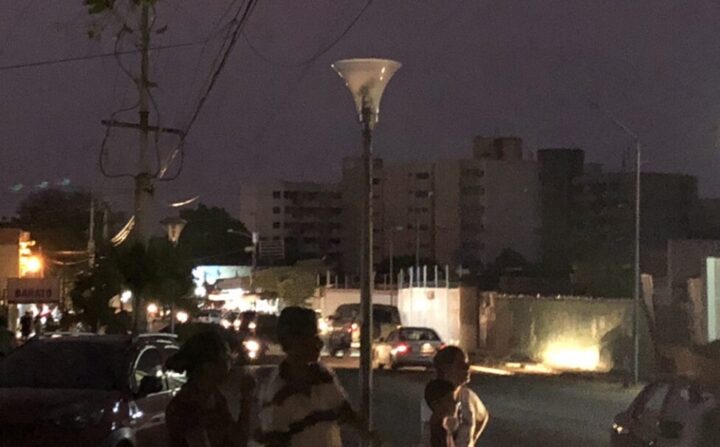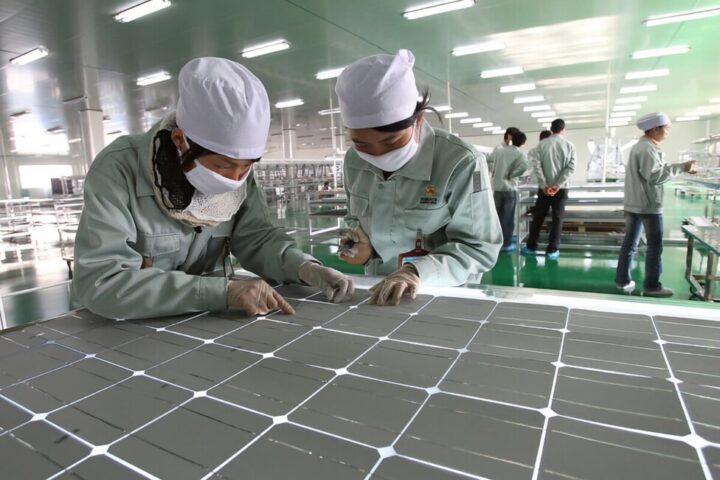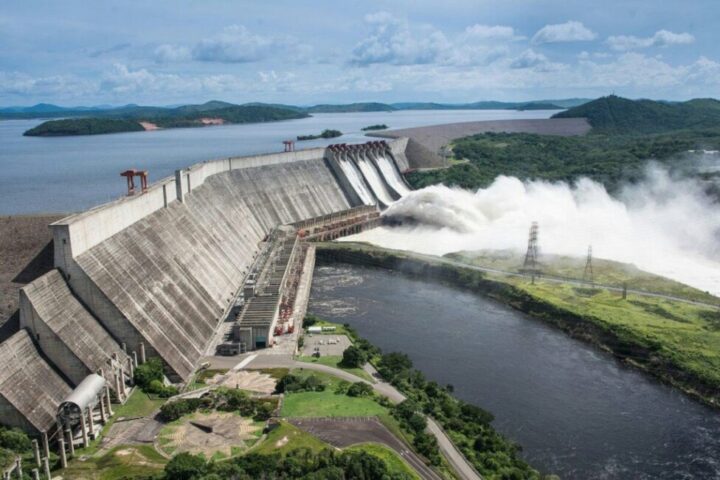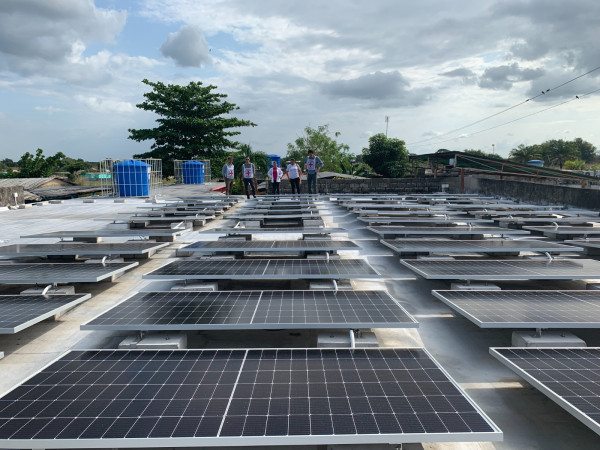
Maracaibo, next to the lake of the same name and the capital of Zulia, one of the regions hardest hit by the electricity crisis in Venezuela, is incubating a citizen initiative so that homes could be equipped with solar panels. Its example has spread to other regions of the country. CREDIT: Uria
By Humberto Márquez
MARACAIBO, Venezuela , Mar 25 2024 – Sweating profusely, unable to sleep because of the heat, fed up with years of blackouts several times a day, many residents of Venezuela’s torrid northwest want to cover the roofs and balconies of their homes with solar panels, and are asking the government to import them massively and cheaply from China.
“It is a proposal to break out of the quagmire immediately, to close the gap between supply and demand for electricity, 60 percent of which in Venezuela goes to residential consumption,” engineer Lenin Cardozo, one of the main promoters of the Zulia Solar and Venezuela Solar citizen initiatives, told IPS.”The solution to the electricity problem no longer lies in thermal plants, which in Venezuela we continue to repair while they are being closed down in other parts of the world, but in new sources and technologies, such as solar power.” — Lenin Cardozo
The northwestern state of Zulia, of which Maracaibo is the capital, produced Venezuela’s great oil wealth throughout the 20th century but has become, along with the neighboring Andes region, the Cinderella of the grid that supplies electricity, generated mainly in the distant southeast of the country, bordering Brazil.
Zulia Solar emerged last year as an association to foment solutions to the lack of electricity suffered by millions of inhabitants of the region. And so far in 2024, replicas have emerged in twenty other states, with aspirations of becoming a national movement: Venezuela Solar.
Its president, lawyer Vileana Meleán, said that “the novelty is that this time the citizens are organized and we are coordinating among ourselves to present the government with this solution that arises from civil society, with a three-point proposal.”
The first point is for the government to massively import solar panels from China, the world’s leading producer – with which Caracas has developed strong commercial and political ties – in order to obtain advantageous prices, and for it to organize a distribution system that makes them affordable to households interested in installing them.
The second is that, in order to lower prices, panels, batteries and other components of solar energy systems should be made exempt from various taxes, such as customs duties and the value added tax.
And the third point calls for the creation of a public and private financing policy, with soft loans, so that families of modest means can purchase the panels and other materials required for the new installation.

Power outages, in the form of sudden blackouts, surprise sectors of the cities of western Venezuela, such as the torrid city of Maracaibo. Local residents are fed up with suffering heat without the possibility of air conditioning or fans, the spoilage of food and damage to their household appliances. CREDIT: Transparencia Venezuela
The reason for the desperation
“When the electricity cuts off, the water goes out, the pumps don’t work. The food in the refrigerator spoils. During the day it is 40 or 42 degrees Celsius, but the thermal sensation reaches 47 degrees,” teacher Rita Zarate told IPS one afternoon in the hallway of her home in the working-class La Pomona neighborhood of Maracaibo.
In the last 24 hours the electricity had been cut three times, lasting between three and four hours each time.
For her family – mother, siblings, children, nieces and nephews – “the worst thing is not being able to sleep when the blackouts happen at night and in the early morning hours. In the bedroom, the heat is unbearable; outside, there are clouds of mosquitoes,” which swarm people in the house when the air conditioning or electric fans are turned off.
A sleepless night, trying to sleep when a breeze blows in the courtyard, keeping the elderly and little ones hydrated, and trying to get transportation to work at daybreak, which might not be available because the blackouts paralyze the fuel pumps and the owners of private vehicles spend hours waiting for the power to come back on so they can fill their tanks.
Zárate said that “it is the same for the children at school: classes two or three days a week, half a day, if they can run the fans. Or in the playground. Sometimes their parents leave them at home, other times the heat gets so bad that we have to send them back.”
Internet to study or to do work, to get administrative procedures done in offices, to operate ATMs in banks, to walk at night under street lights? These are options that are vanishing for those who live on the shores of Lake Maracaibo.
“In the last century Maracaibo was jokingly called ‘the coldest city in Venezuela’ because there was air conditioning everywhere. That’s not true anymore, they only work off and on now,” Luis Ramírez, director of the graduate program in quality systems at the private Andrés Bello Catholic University (Ucab), based in Caracas, told IPS.
He said that many homes in Zulia and the other 22 states outside Caracas have small gasoline-powered generators, but due to the scarcity of fuel – paradoxically, in the country that boasts the largest oil reserves on the planet – they are used less and less.
Zárate remains hopeful that change will come. But with regard to solar panels, he said that “I’ve heard about them, but it sounds like a distant solution,” and added that “one thing is for sure: with our income (every adult in his family earns less than 60 dollars a month) we won’t be able to afford them.”

Workers in a solar panel factory in China, by far the world’s largest producer. The Zulia and Venezuela Solar associations are asking the government to use its political and commercial ties with Beijing to negotiate a massive import of solar panels, and to make them affordable by eliminating taxes and granting soft loans. CREDIT: Xataka
Problems and hopes
Meleán proposed to her supporters in Zulia Solar and Venezuela Solar “to hold on now more tightly to the hope” that the acquisition and installation of solar panels will become widespread, based on a speech by President Nicolás Maduro, who is seeking reelection on Jul. 28 to a third six-year term.
At a Mar. 13 campaign rally, Maduro said that “the social movements have proposed a 2025-2030 plan for solar energy to reach the communal councils, the homes, the urban developments. It is one of the great solutions for the 21st century.”
At the end of the 20th century, Venezuela had a nominal installed generation capacity of 34,000 megawatt hours (MWh), including 18,000 MWh in thermal plants and 16,000 MWh in hydroelectric plants, and the peak demand of 18,000 MWh was reached in 1982.
From that year on, economic crises followed one after the other, reducing demand and the operability of the facilities. In the second decade of the 21st century, the country experienced a recession that cut GDP by four-fifths, while power plants and grids deteriorated until they generated no more than 10,000 MWh.
Experts put current demand at about 12,000 MWh, and the gap between supply and demand has led to energy rationing based on outages that affect almost the entire country – with the exception of Caracas – but especially the west, the region most distant from the southeastern Guri hydroelectric power plant, which generates two-thirds of the electricity consumed.
Zulia is barely surviving on what it receives from the Guri power plant and a dozen thermal power plants, which have deteriorated after being designed to be gas-fired and instead use diesel, contributing to their inefficiency and decline.
Cardozo said “the solution to the electricity problem no longer lies in thermal plants, which in Venezuela we continue to repair while they are being closed down in other parts of the world, but in new sources and technologies, such as solar power.”

Two thirds of Venezuela’s electricity depends on the Guri hydroelectric power plant in the southeast of the country. The distance and the poor state of the transmission and distribution networks result in supply failures in the western part of the country, fueling the search for alternatives such as solar panels in homes. CREDIT: Corpoelec
Venezuela “needs to incorporate technologies such as solar power, as an alternative to cover the gap between supply and demand in the short term, and with decentralized initiatives until large projects can move forward,” he said.
He added that a solar panel that costs 30 or 50 dollars in China, for example, depending on its capacity, sells for 10 times that in Venezuela, due to the costs and taxes along the supply chain.
Hence Venezuela Solar’s proposal for the government to intervene with massive purchases from its giant Asian partner, to abolish the taxes on their import and commercialization, and to facilitate financing for households.
Cardozo stressed that constant technological advances will make it possible not only to reduce the cost but also the size and complexity of domestic solar installations.
He estimated that a household could produce enough power for essential consumption with two 500-watt panels, and could run an air conditioner with four more, at a cost of about 1,000 dollars.
That would be the result if the government fully embraces Venezuela Solar’s proposals. The Zulia Solar group is preparing a pilot test in Maracaibo, with 400 houses that would have panels on their roofs and 100 apartments that would have panels on their balconies.

Solar panels supply energy to a health center in El Cruce, a remote village in the state of Zulia, in the far western part of the country, bordering Colombia. In the recent past, small hybrid wind and solar systems have been installed in isolated communities, but most have been lost due to lack of maintenance. CREDIT: ICRC
Not everything is positive
Representatives of companies that in the last three years have installed solar panels in homes and businesses in Venezuelan cities estimate costs of 4,000 dollars or more for an installation that meets the basic needs of a home.
In this country of 29 million inhabitants, the average salary is around 130 dollars per month, according to consulting firms. Measured by income level, 82 percent of households live in poverty and more than 50 percent in critical poverty, according to the Ucab Living Conditions Survey, released this month.
Ramírez pointed out that Maracaibo was not only the artificially coldest city in the country, but also the one with the highest electricity consumption per person, “and that is why aiming at a mass solution with solar panels on roofs and balconies requires a kind of prior census to estimate the real amount of equipment needed.”
Another expert, Alejandro López-González, told IPS that “Venezuela’s electricity problem will not be solved with solar panels on the roofs of homes in its big cities. It is not possible, because of our climate, which demands a high level of air conditioning.”
“If we turn to a complementary development of renewable energies, the ideal would be large solar and wind farms, because they provide higher energy intensity, for a greater capacity of use, and with a moderately centralized distribution system,” said López-González.
He argued that while the installation of panels in homes also complements local or regional grids, it falls short of solving the electricity crisis.
On the other hand, he noted that the assembly of solar panels began 14 years ago in Venezuela, in a state-owned plant that has worked intermittently but which could be reopened, while other factories could be built, if an agreement is reached with China for production and not only for imports.
In his book “Renewable Energíes in Venezuela. Experiences and lessons for a sustainable future”, López-González compares the country’s solar and wind potential.
This country’s solar power potential is among the highest in Latin America, with an average of 5.35 kilowatt hours per square meter per day (5.35 kWh/m2), close to the highest, in Chile (5.75) and Bolivia (5.42), according to studies by the Venezuelan University of Los Andes, based in the western Andean state of Mérida.
With respect to wind energy, in the northwest of the country alone, the potential reaches 12,000 MWh – similar to the capacity of Guri -, favored by trade winds with high levels of constancy, direction and speed, up to eight meters per second.
Venezuela also has the potential to develop solar farms and wind farms on its Caribbean islands and northeastern mainland coast to add thousands of MWh, which could limit thermal plants to a complementary status.
Between 10 and 15 years ago, the government installed up to 50 MWh of wind power generation and more than 2,000 small hybrid systems – solar and wind – through the “Sembrando luz” program, mainly in remote indigenous and peasant communities, which has been abandoned for the past decade.
Currently there are some isolated installations in several cities – mainly businesses – and small hybrid systems on livestock farms or large plantations, to ensure the refrigeration of products or to operate water wells.
Against this backdrop, with constant blackouts and as the country heads towards a new presidential election on Jul. 28, Venezuela and Zulia Solar activists are betting that their proposals will prosper.
“The country is beginning to rethink other ways to address its electricity security problem. The value and strategic use of solar energy has been incorporated into the public agenda as an immediate solution to overcome the current electricity crisis,” said Cardozo.